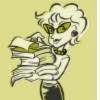 Yep, Lawrence. 2000. THE MAGIC PAINTBRUSH. New York, NY: Harper Collins. ISBN 9-780-0602-8199-1
Yep, Lawrence. 2000. THE MAGIC PAINTBRUSH. New York, NY: Harper Collins. ISBN 9-780-0602-8199-1PLOT SUMMARY
When Steve’s parents die, he must go to live with his only remaining relative, his grandfather. Steve isn’t sure of which he is more afraid—his grandfather or new neighborhood, Chinatown. Now, the one thing that gives Steve happiness is in jeopardy. Steve loves to paint. But, his brush is old and frayed and his grandfather cannot afford a new one. In a surprising twist, Steve’s grumpy grandfather gives him a paintbrush which is imbued with magical powers. Through this gift, Steve, his grandfather and those around them learn new things about living in Chinatown and what it truly means to be happy.
CRITICAL ANALYSIS (INCLUDING CULTURAL MARKERS)
THE MAGIC PAINTBRUSH uses a common theme as his vehicle for this story about a Chinese-American boy and his grandfather. Through the use of plot, setting, and characterization Lawrence Yep writes a tale in which unexpected—and sometimes unbelievable—events occur as a means of binding this family together and helping them find happiness.
The theme in THE MAGIC PAINT BRUSH is a common one. A boy loses his parents and, therefore, must go to live with a relative whom he does not know. However, this frequently-used theme takes a turn when the grandfather gives Steve a magic brush. Everything he paints becomes real. None of the characters; neither Steve, his grandfather, nor his Uncle Fong are happy with their lives. With this paintbrush they learn to be content with their lives rather than resentful. At first, the magic is predictable and helpful. As the story progresses, the journeys they take with the paintbrush become surreal. This step into the bizarre detracts from the message of the story and the reader’s ability to suspend disbelief.
Yep’s use of characterization is this story’s best quality. Steve is an eight-year-old boy who feels he alone is grieving his parents’ death. His grandfather not only doesn’t seem to mourn their death, he apparently dislikes Steve and resents having to care for him. Steve recalls that his grandfather “never spoke to [him] except to scold him” (p. 2). However, when Steve comes home late from school, the grandfather’s worry surprises him. “You were worried about me?” (p. 7). Slowly, Steve and his grandfather realize they have much in common and differ mainly in the expression of their emotions. This difference is not only generational, but also cultural. Steve was born in the United States while his grandfather was born in China and became a “Chinatowner.”
The setting gives glimpses of several places: Chinatown in San Francisco, a peach orchard in Dragon Back village in China, and Chinatown’s “moon.” Each of these places is distinctly different and shows a different side of Chinese-American culture portrayed in THE MAGIC PAINTBRUSH. To Steve, Chinatown is a scary, foreign neighborhood of dark doorways, dingy apartment buildings and narrow alleyways. Dragon Back, Uncle Fong’s hometown, is a light, airy village surrounded by a fragrant orchard. Dragon Back’s irrigation system, called a water chain, alludes to the time and place which they are visiting. Lastly, a cassia tree, an enchanted rabbit and a small pagoda style building represent the Chinatown moon: a mythical place from the Chinatown story, The Lady on the Moon.
The plot, characters, and setting in THE MAGIC PAINTBRUSH provide a taste of Chinese-American culture, especially as it is in San Francisco’s Chinatown. While the plot twists are somewhat strange, Yep’s characters and use of varied settings give the reader a plethora of details which allow insight to this ancient yet dynamic culture.
REVIEW EXCERPTS
“Ancient popular Chinese myths as well as some more recent urban Chinese legends are woven into this story of modern America. . . . Written at an easy level, this is a great story for the elementary grades” (Multicultural Review)
“Steve learns about his grandfather's past, about Chinese legends, and about life as a "Chinatowner." Through simple yet sensitive dialogue, the author weaves a tale of alienation turning into affection, and of good prevailing over meanness.” (School Library Journal)
“Set in San Francisco's Chinatown, this novel mixes elements of fantasy and fairy tale as an eight-year-old boy gets a paintbrush that transforms his dreary life. "Snappy dialogue, realistic characters and plenty of wise humor keep the pages turning,” (Publisher’s Weekly)
Reviews obtained from Follett Library Resources and accessed at:
http://www.flr.follett.com/search?SID=c211074453f514ff63ced2a0fe154f24
and from Book Review Digest Plus database, courtesy of Texas Woman’s University Library.
CONNECTIONS
Other books by Lawrence Yep:
THE DRAGON PRINCE: A CHINESE BEAUTY & THE BEAST TALE. ISBN 978-0-06-443518-5
COCKROACH COOTIES. ISBN 978-0-7868-1338-4
THE CASE OF THE GOBLIN PEARLS. ISBN 978-0-06-440552-2
Other picture books and young adult novels about Chinese Americans:
Yamate, Sandra S. 2000. CHAR SIU BAO BOY. NY: Polychrome. ISBN 978-1-879965-19-5
Roth, Susan L. 2001. HAPPY BIRTHDAY, MR. KANG. National Geographic Society. ISBN 978-0-7922-7723-1
Yin. 2001. COOLIES. NY: Philomel Books. ISBN 978-0-399-23227-5
Yin. 2006. BROTHERS. NY: Philomel Books. ISBN 978-0-399-23406-4


